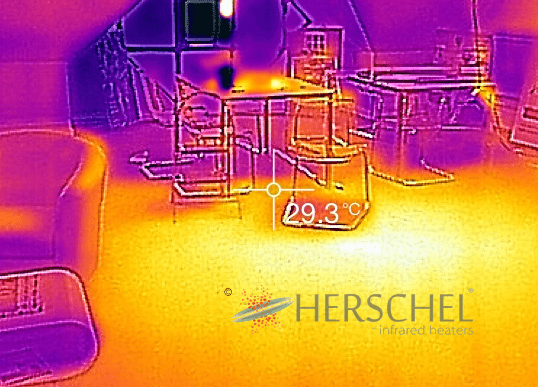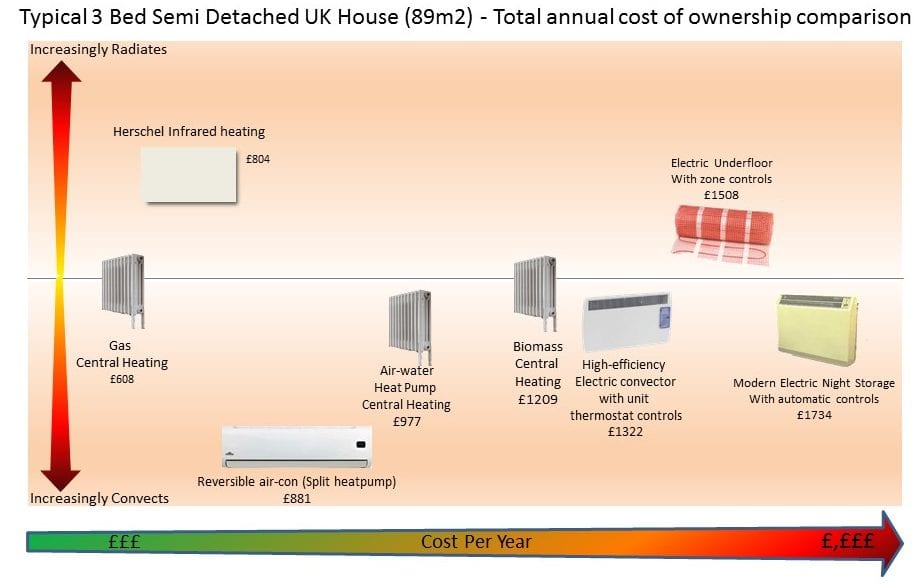
When considering a purchase of a heating system, there are a number of different costs over the entire lifetime of the heater that need to be considered to make a good investment decision. Each heater type on the market has different strengths and weaknesses when it comes to lifetime costs of the solution and the team from Herschel Infrared made a comparison of all these costs to determine how much each heater type really costs its owner over its lifetime.
For example: if the purchase and installation costs of a heating system are high and the lifetime is short, is it much benefit that the running times are cheap?
If a heating system is going to save money, this means it must be less expensive to own over its lifetime than other solutions. This is what the Herschel team worked out:
 This image shows the increasing cost of ownership of different heat solutions (with higher cost systems to the right). What Herschel did was to take all cost components of a system: purchase; installation; running cost; maintenance charges; cost to replace and longevity. This allowed them to compile a year on year cost of owning the system based on all these factors and the cost to replace at the end of its life.
This image shows the increasing cost of ownership of different heat solutions (with higher cost systems to the right). What Herschel did was to take all cost components of a system: purchase; installation; running cost; maintenance charges; cost to replace and longevity. This allowed them to compile a year on year cost of owning the system based on all these factors and the cost to replace at the end of its life.
So the figure in £ in the image is not the annual running cost but the annual cost to own a particular system each year. A 3 bedroom house was used in all comparisons, to ensure all systems were correctly sized to heat the same space to a comfortable level.
All figures were taken from their respective manufacturer websites & the UK Energy Savings Trust calculations for a 3 bedroom house. Grants and incentives offered on certain systems were not included.
Major differences accounting for the different rankings were found to be as follows:
| Infrared vs Heatpumps | Infrared vs Night Storage heaters | Infrared vs Biomass |
| ■ much cheaper purchase price ■ much lower installation costs ■ no maintenance contracts necessary ■ when a heat pump fails everything fails – large repair / replacement cost for parts ■ no system issues (re-gassing, plumbing issues) ■ radiant heating Vs heating the air | ■ far more economical during the day than storage is at night ■ direct response to control inputs ■ does not require Economy 7 (higher daytime tariff) ■ storage requires from 10 – 15% daytime top-up | ■ significantly cheaper purchase price ■ much lower installation costs ■ no maintenance contracts necessary ■ no ordering, delivery and storage of pellets / fuel ■ no system issues (plumbing issues) |
Infrared can become free when combined with Solar PV
The final large “plus” with Infrared is that because it stores energy in the building and all the panels are individually powered and controlled it is an ideal system to run in combination with Solar PV. When extra power becomes available from a PV system, it makes sense to divert it to energy storage activities such as heating hot water and building up thermal mass, both becoming “free” heat at the point of use, as well as reducing the thermal requirements of the house when the sun goes down in the evening.
It makes more sense that the future of heating is in a daytime storage model (building up thermal mass in the building) and using solid state technology (no moving parts) as this is the only way to reduce overall ownership costs and replacement intervals.
Conclusion
Choosing your heating system is an important investment decision. Property owners should understand all the costs implied in their purchase, as this cannot be solely based on running costs. The low running costs of many “eco” options belie their large purchase and installation costs which take many years to recoup (assuming faultless lifetime running in the mean time).
Whilst gas is still the cheapest form of heating energy in the UK currently, electricity is set to become less penalised under future buildings performance assessments as cleaner forms of generation become a greater part of the contribution to the grid. Infrared heating is well poised to become one of the cheapest lifetime heating solutions you can purchase. It is easy and cheap to install; economical to run; requires no maintenance. Replacement of panels is infrequent (guaranties are 5 – 10 years) and only imply single panels at a time and not the whole system.
